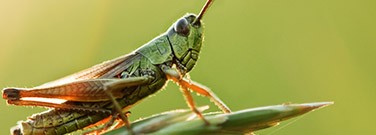Locusts Are Helping Scientists Understand Smell

By Kylie Wolfe
When you walk down a city street, you might smell pizza or coffee or bread as you pass a local shop. You might also smell exhaust from a car or trash from a nearby dumpster. These scents are distinct, and your brain doesn’t hesitate to recognize the difference.
Researchers at the McKelvey School of Engineering at Washington University in St. Louis wanted to learn more about this odor-identifying process. The team observed the neural responses of locusts to better understand how the activation of certain cells translates to behavior. Their findings were published in Proceedings of the National Academy of Sciences.
Brain and Behavior
The research team began by training locusts to associate a smell with the promise of food. The locusts were given either hexanol or isoamyl acetate to smell, followed by grass to eat. Just like Pavlov’s dogs, a famous example of classical conditioning, the locusts quickly learned to make the connection between the odor and a snack and would open the appendages near their mouths known as palps.
When researchers assessed which neurons were active in the presence of an odor, they noticed different responses. Even though the patterns were inconsistent, the locusts exhibited the same behavior each time: opening their palps.
"The neural responses were highly variable," Barani Raman, professor of biomedical engineering at Washington University, told Science Daily. "That seemed to be at odds with what the locusts were doing, behaviorally."
Neural Response
Locusts sense the presence of an odor via olfactory receptor neurons in their antennae. These signals are transmitted and drive a response from other neurons. Even though the cellular responses varied, researchers saw the same physical action. To better understand, they defined two neural states: ON and OFF.
The ON neurons were active when an odor was present. The OFF neurons were active when an odor was not present. No matter the experimental conditions, the ON neurons would activate in the presence of an odor and the locusts’ palps would open. Therefore, if enough ON neurons were active and OFF neurons inactive, scientists could predict the locusts’ behavior.
A Simple Conclusion
The Washington University research team has learned much about the brains and behaviors of locusts over years of study. One of their goals is to engineer a bomb-sniffing version of the species. For now, they’re gaining a better understanding of the mechanisms these insects use to detect odors.
"We were surprised to find that this simple approach is all that was needed to robustly recognize an odorant," said Raman.

